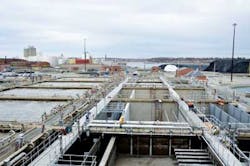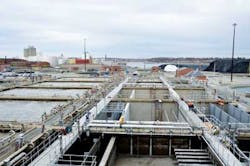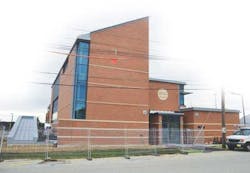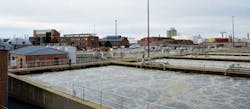Advanced Planning: Phased Construction Helps Deliver World's Largest IFAS System Upgrade
By Edward V. DiSalvio, P.E., and David Peterson, P.E.
Like many other water and wastewater treatment plant owners and operators, the Narragansett Bay Commission in the state of Rhode Island faces ever-tightening permitting requirements.
Case in point: a supplemental NPDES permit required that operators at the Field's Point Wastewater Treatment Facility (WWTF) in the city of Providence reduce total effluent nitrogen to 5 mg/L or less on a seasonal basis, which will subsequently help to protect water quality in the region and reduce the amount of nitrogen flowing into Narragansett Bay.
The Field's Point WWTF has a design average flow of 50 million gallons per day. It can provide secondary level treatment for up to 77 MGD and primary treatment for an additional 123 MGD, for a total wet-weather capacity of 200 MGD. Wastewater is treated from Providence, the town of North Providence, the town of Johnston, and parts of the town of Lincoln and the city of Cranston.
With little space on the Field's Point WWTF site for additional equipment or structures to accommodate nitrogen removal systems, a tight budget and looming permit deadlines, the Commission opted for a $65-million facility upgrade that included the implementation of the largest Integrated Fixed Film Activated Sludge (IFAS) biological nutrient removal process in the world.
Operational Objectives
In 2011, the Narragansett Bay Commission selected Kleinfelder to complete the Field's Point upgrade. The agency stipulated that the plant operate at peak efficiency and within required treatment limits throughout the four-year modernization and construction effort. The upgrade was to include three new buildings as well as renovations to 12 existing buildings and tank structures.
The primary structures included:
- New Operations and Administration Building: The 25,000- square-foot, three-story structure was designed to meet the U.S. Green Building Council LEED Silver standard. It is steel-framed with a cast-in-place concrete foundation system and has lateral load resisting system steel braced-frames and non-load bearing masonry infill walls.
- New Carbon Feed Building: The 1,200-square-foot, single-story structure has an adjacent chemical tank farm. The building is steel-framed with cast-in-place concrete foundations and has non-load bearing masonry exterior walls and vertical steel braced frames.
- New Screening and Caustic Building: The 4,400-square-foot, single-story structure is steel-framed with cast-in-place concrete foundations. It has non-load bearing masonry exterior walls; vertical steel braced frames; and gable roof using steel trusses.
- Blower Building: An existing 2,100-square-foot, two-story masonry structure underwent structural investigation and condition assessment. The second floor system was strengthened in order to support new equipment loads; existing masonry walls were modified and strengthened to provide new equipment openings; and pipe supports were installed.
- Aeration Tanks: Ten existing cast-in-place tanks were subdivided using new cast-in-place concrete walls and FRP walls. New walkways were constructed around the top of the tank walls. Each tank is approximately 73 feet x 104 feet x 20 feet and new equipment for the IFAS system was installed within the tanks.
- Screw Pump Lift Station: Existing screw pump machinery needed to be replaced. A structural investigation and condition assessment were performed. The project featured phased design and construction. New concrete equipment supports and foundations were installed.
Phased for Efficiency
An additional challenge for the design team was to develop a construction phasing plan that would keep the wastewater treatment plant operating within required treatment limits throughout the four-year modernization and construction effort. The clear and comprehensive construction phasing plan put in place prior to construction included approaches to minimize operating disruptions and optimize construction schedules.
Three specific examples of phased construction - aeration tank conversion, screening and caustic building construction, and turbo blower conversion - exhibit how the project was phased for efficiency.
In the case of the aeration tanks, permit limits required that the plant's 10 aeration tanks be converted to the IFAS process a few at a time. However, for efficient and cost-effective conversion, it was important that the contractor could move directly from one aeration tank to the next with little to no downtime. This required coordination between the owner, engineer, general contractor, and subcontractors to ensure that tank conversions went smoothly and without risking process upset or permit violations.
The 10 biological process reactors were converted from activated sludge to the IFAS process over a period of two years. In late 2012, all 10 basins at Field's Point WWTF had been converted to the IFAS process, started up and were operational. By September 2012, the total nitrogen concentration dipped to below 5 mg/L with no optimization of internal recycle rates and no alkalinity feed or carbon dosing.
The second example of phased efficiency was realized in the construction of the screening and caustic building. Due to site constraints, the structure was constructed directly above two live 60-inch diameter PCCP gravity pipelines connecting primary treatment to the screw pump lift station. To maintain flows and avoid costly bypass pumping, the building was designed with three distinct foundations and a series of temporary bulkheads that could be staged in such a way as to always have one of the 60-inch lines online. Once the new screening process was installed, the remaining 60-inch line was demolished and the remainder of the building was constructed. While a bypass pump system was installed as a standby system, it was never required to operate other than to exercise the equipment.
The third example of phased efficiency occurred during the installation of the turbo blower. The new IFAS process requires approximately three times the aeration capacity as the former process. Through the selection of innovative turbo blower technology, a total of nine new turbo blowers were installed in the footprint that was formerly occupied by the intake filter boxes for five centrifugal blowers.
Due to the small footprint and high efficiency of the turbo blowers, it was possible to provide additional aeration capacity without a building expansion. Also, a new electrical room and storage area was able to occupy the space formerly taken up by the centrifugal blowers. Finally, the flexibility of the technology allowed for installation in phases, while keeping full aeration capacity to the plant during construction.
Kleinfelder, as the engineering and construction team lead, is finalizing the IFAS process optimization with anticipated completion of the project by the end of winter 2014.
Ultimately, designing the buildings for phased construction eliminated the need to use bypass pumping, which saved the client $1.5 million and resulted in completion of the project one year ahead of schedule. This project exhibits how advanced planning can facilitate efficient construction, while limiting process interruptions and saving cost.
About the Authors: Edward V. DiSalvio, P.E., is a project manager and principal structural engineer with Kleinfelder. He can be reached at (617) 498-4609 or [email protected]. David Peterson, P.E., is a project professional with Kleinfelder. He can be reached at [email protected].



